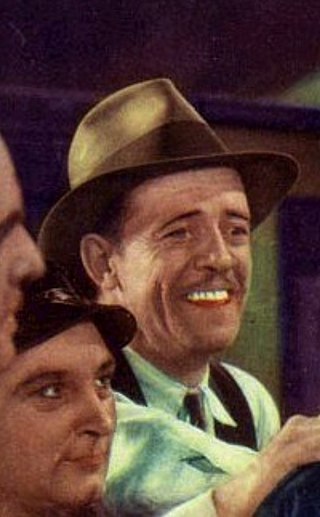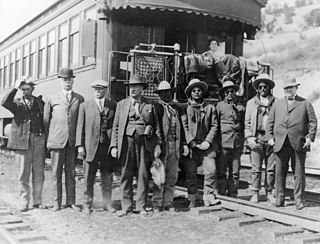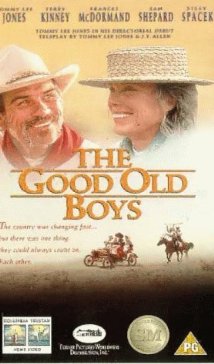Related Research Articles

Philo Taylor Farnsworth was an American inventor and television pioneer. He made the critical contributions to electronic television that made possible all the video in the world today. He is best known for his 1927 invention of the first fully functional all-electronic image pickup device, the image dissector, as well as the first fully functional and complete all-electronic television system. Farnsworth developed a television system complete with receiver and camera—which he produced commercially through the Farnsworth Television and Radio Corporation from 1938 to 1951, in Fort Wayne, Indiana.

Richard William Farnsworth was an American actor and stuntman. He was twice nominated for an Academy Award: in 1978 for Best Supporting Actor for Comes a Horseman, and in 2000 for Best Actor in The Straight Story, making him the oldest nominee for the award at the time. Farnsworth was also known for his performances in The Grey Fox (1982), for which he received a Golden Globe Award nomination for Best Actor in a Motion Picture - Drama, as well as Anne of Green Gables (1985); Sylvester (1985), and Misery (1990).

James Butler Hickok, better known as "Wild Bill" Hickok, was a folk hero of the American Old West known for his life on the frontier as a soldier, scout, lawman, cattle rustler, gunslinger, gambler, showman, and actor, and for his involvement in many famous gunfights. He earned a great deal of notoriety in his own time, much of it bolstered by the many outlandish and often fabricated tales he told about himself. Some contemporaneous reports of his exploits are known to be fictitious, but they remain the basis of much of his fame and reputation.

Anthony Wilford Brimley was an American actor. After serving in the U.S. Marine Corps and working odd jobs in the 1950s, Brimley started working as an extra and stuntman in Western films in the late 1960s. He became an established character actor in the 1970s and 1980s in films such as The China Syndrome (1979), The Thing (1982), Tender Mercies (1983), The Natural (1984), and Cocoon (1985). Brimley was known for playing characters at times much older than his age. He was the long-term face of American television advertisements for the Quaker Oats Company. He also promoted diabetes education and appeared in related television commercials for Liberty Medical, a role for which he became an Internet meme.

Tom London was an American actor who played frequently in B-Westerns. According to The Guinness Book of Movie Records, London is credited with appearing in the most films in the history of Hollywood, according to the 2001 book Film Facts, which says that the performer who played in the most films was "Tom London, who made his first of over 2,000 appearances in The Great Train Robbery, 1903. He used his birth name in films until 1924.
"I Am the Night—Color Me Black" is episode 146 of the American television anthology series The Twilight Zone. It originally aired on March 27, 1964 on CBS.

Charles McGraw was an American stage, film and television actor whose career spanned more than three decades.

Wild West C.O.W.-Boys of Moo Mesa is a 1992 American animated television series created by comic book artist Ryan Brown, known for his work on Teenage Mutant Ninja Turtles. It aired as part of ABC's Saturday morning lineup.
"Black Leather Jackets" is episode 138 of the American television anthology series The Twilight Zone. In this episode, three aliens disguised as young men in leather jackets encounter a kink in their plan to exterminate humankind when one of them falls in love with a human girl.
"Mr. Garrity and the Graves" is an episode of the American anthology television series The Twilight Zone.

The Plainsman is a 1936 American Western film directed by Cecil B. DeMille and starring Gary Cooper and Jean Arthur. The film presents a highly fictionalized account of the adventures and relationships between Wild Bill Hickok, Calamity Jane, Buffalo Bill Cody, and General George Custer, with a gun-runner named Lattimer as the main villain. The film is notorious for mixing timelines and even has an opening scene with Abraham Lincoln setting the stage for Hickok's adventures. Anthony Quinn has an early acting role as an Indian. A remake using the same title was released in 1966.
Buffalo Bill is a 1944 American Western film about the life of the frontiersman Buffalo Bill Cody, directed by William A. Wellman and starring Joel McCrea and Maureen O'Hara with Linda Darnell, Thomas Mitchell, Edgar Buchanan and Anthony Quinn in supporting roles.

Bowery Buckaroos is a 1947 American comedy film directed by William Beaudine and starring the comedy team of The Bowery Boys. It is the eighth film in the series and the last Bowery Boys film that Bobby Jordan appeared in.

The Cochise County Cowboys is the modern name for a loosely associated group of outlaws living in Pima and Cochise County, Arizona in the late 19th century. The term "cowboy", as opposed to "cowhand," had only begun to come into wider usage during the 1870s. In that place and time, "cowboy" was synonymous with "cattle rustler". Such thieves frequently rode across the border into Mexico and stole cattle from Mexican ranches that they then drove back across the border to sell in the United States. Some modern writers consider them to be an early form of organized crime in America.

The Posey War was a small, brief conflict with Native Americans in Utah. Though it was a minor conflict, it involved a mass exodus of Ute and Paiute native Americans from their land around Bluff, Utah to the deserts of Navajo Mountain. The natives were led by a chief named Posey, who took his people into the mountains to try to escape his pursuers. Unlike previous conflicts, posses played a major role while the United States Army played a minor one. The war ended after a skirmish at Comb Ridge. Posey was badly wounded and his band was taken to a prisoner-of-war camp in Blanding. When Posey's death was confirmed by the authorities, the prisoners were released and given land allotments to farm and raise livestock. According to the Utah Encyclopedia, "for the Indians it was not a war and never was intended to be such ... a few shots fired as a delaying action, and a very rapid surrender do not justify elevating an exodus to a war."

The Bluff War, also known as Posey War of 1915, or the Polk and Posse War, was one of the last armed conflicts between the United States and Ute and Paiute Native Americans (Indians) in Utah. In March 1914, several Utes accused Tse-ne-gat, the son of the Paiute Chief Narraguinnep ("Polk"), of murdering a shepherd named Juan Chacon. When a posse attempted to arrest Tse-ne-gat in February 1915, the Paiute and Ute bands headed by Polk and Posey resisted and several people on both sides were killed or wounded. The conflict took place near the town of Bluff, Utah. In March 1915, after negotiations, Polk surrendered Tse-ne-gat to U.S. Army General Hugh L. Scott. In July 1915 he was found innocent of murder in a trial in Denver.

Brigham City is a 2001 murder mystery independent film. It was written and directed by Richard Dutcher, who also plays in the main role of Sheriff Wes Clayton. It was financed by private investors.
John Dennis Johnston is an American film and television actor.

The Good Old Boys is a 1995 American Western television film directed by Tommy Lee Jones and written by Jones and J.T. Allen, based on the 1978 novel of the same name by Elmer Kelton. Jones stars alongside Terry Kinney, Frances McDormand, Sam Shepard, Sissy Spacek, Wilford Brimley, and Matt Damon. The film aired on TNT on March 5, 1995.

Frontier Days is a 1934 American western film directed by Robert F. Hill and starring Bill Cody, Ada Ince and Wheeler Oakman. It was produced by independent Poverty Row outfit Altmount Pictures for release as a second feature. Location shooting took place in the Alabama Hills in California.
References
- ↑ Brooks, Tim; Marsh, Earle (2007). The Complete Directory to Prime Time Network and Cable TV Shows 1946-Present . Ballantine Books. ISBN 978-0-345-49773-4.RetrievedJuly 23, 2024. p. 175.
- ↑ D'Arc, James V. (2010). When Hollywood came to town: a history of moviemaking in Utah (1st ed.). Layton, Utah: Gibbs Smith. ISBN 9781423605874.